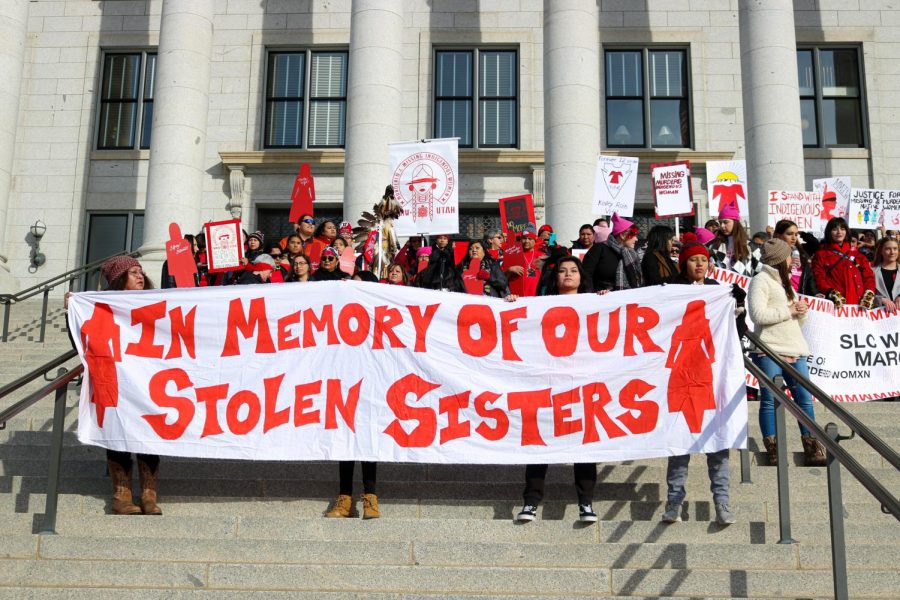Alexander: Indigenous Women and Girls Deserve Justice
January 23, 2021
Many people seek justice for a loved one after they experience a violent crime through the help of law enforcement. But for Indigenous communities, a harsh reality awaits — one where families are often left in the dark, ignored and met with indifference when asking police for help. On reservations, where murder is the third-leading cause of death for Native American women and rates of violence can be 10 times higher than the national average, the police can be anything but helpful.
For decades, this epidemic was placed on the back-burner of society’s concerns, ignored by the masses and media alike. Law enforcement’s failure to report or record these violent crimes against Indigenous peoples further aided in downplaying the severity of the racial injustice. Yet after the nation’s racial reckoning in June, seeking equality and justice for these women should be a priority. Utah Rep. Angela Romero’s HB 41 gives these women a fighting chance, by compiling different sources to create a Murdered and Missing Indigenous Women and Girls Task Force, which will help with investigations and bring justice to these women and families. The work that the MMIWG Task Force plans on doing will bring Utah closer to both racial equality in our justice system and closure for families affected by these violent crimes.
Responding to Crimes
One of the issues directly contributing to injustice in Indigenous communities is law enforcement’s response time. For people living on reservations, police response is horrifically delayed, as an officer may take hours, if not days, to respond to a crime. There are a few unique rules worth noting that affect how outside law enforcement can act on reservations, specifically regarding their limitations to intervene and actually carry out arrests — if the suspect and/or victim is Native American or not. And whether a lack of technology is to blame, or the internal prejudices some have towards Native Americans that date back to colonial times, neither is reason to prevent justice from being served.
Now, the task force is commissioned to report and plan how to prevent this behavior among law enforcement. The task force will “develop model protocols and procedures” to apply to cases of MMIWG, in turn “improving the way law enforcement investigators and prosecutors respond to the high volume of the cases, and to the investigative challenges that might be presented in cases involving female victims.” Through these measures, Utah’s police can learn to accommodate and carry out these investigations in a coherent and effective manner, and we can start to close the racial gap in our state’s justice system and bring answers to Indigenous families.
Documenting Crimes
However, even after the police eventually arrive, problems still remain. Significantly affecting injustice among Indigenous families is documentation. How law enforcement and major divisions of crime data keep track of these cases is utterly inefficient. Failure to record crimes, misclassification of victims and lack of research further promote a sense of inferiority among cases of Indigenous women and girls. With only 2% of MMIWG cases logged into the federal Department of Justice database of missing persons in 2016, gathering statistics and developing new practices to combat this violence is almost impossible. However, with the work of the new task force, Utah could make “better use of existing criminal databases” and collect and share data “among various jurisdictions and law enforcement agencies.” Through working with tribes, agencies and families to review cases and increase input, Utah can help resolve cold cases and support law enforcement in MMIWG investigations.
Covering Crimes
The last issue further suppressing a sense of equality among Native Americans is how the media covers violent crimes against Indigenous women and girls. In 2017, more than 95% of cases studied were never covered by the national media. And out of 506 cases represented in the study, only a quarter of them were reported by local, national or regional media. And the problem stems at least in some part from police documentation — with the chain of communication already flawed in law enforcement agencies, accurate information can rarely reach the media, making it difficult for the press to report on these violent crimes. And when actually reported on, the coverage of these cases more often than not involves violent language, which detracts from the actual severity of the case and instead focuses on furthering a sense of inferiority among Native Americans.
The lack of coverage by the media on these issues is problematic to Indigenous peoples and police response. If the crimes are never taken seriously by society or the police, then Native Americans will never be able to seek justice and equal treatment in the justice system. The new task force won’t be able to immediately change the way the media covers these violent crimes, but enhancing the data and research about the nature of these crimes will encourage the media to equally report and bring attention to these pressing issues. In turn, the task force can provide agencies more information and help in investigating these crimes, and Indigenous families can once again become equal in priority for justice.
While there is still plenty to do in creating an equitable justice system, Utah’s MMIWG task force could be monumental in sustaining reformative changes in how police and law enforcement agencies respond to and investigate violent crimes against these Indigenous women. Utah’s police would be able to begin to understand and navigate the challenges that obstruct them from carrying out equal justice. We could root out sources of indifference, find the problems that prevent thorough investigations and start treating Indigenous victims with the respect and urgency they deserve.








